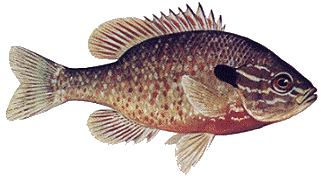A male bluegill can easily be taken on weighted flies during
the spawn, not because he is hungry, but because he is determined
to keep intruders away from his nest. One afternoon I watched the
activity at the spawning area for some time, interested in how
persistently the males guared their nests. I threw an unhooked
garden worm into one of the beds and watched while the male darted
at it, picked it up in his mouth and carried it away from the bed, then
dropped it and hurried back to his station. Any other time he would
have consumed that worm in a single gulp.
A bluegill reacts the same way when a fly enters his area. He'll
strike at it to move it away and if that doesn't work he'll tkae it in his
mouth to move it. Once it's in his mouth all you have to dois set the
hook and play the fish. A size 8 weighted yellow, green or brown Wooly
Worm or size 10 weighted Girdle Bug fished in bedding areas will help
you to quickly fill your fish basket with bluegill.
A few days after the fly hatch they are large and strong enough to
adequately fend for themselves, so the male leave the spawning area. He
heads for deeper, cooler water to rest and feed while recovering from those
long days of protecting his spawning area and the fry. Fly fishermen can
take advantage of the fish's returing appetite by using wet flies and nymphs in
the deeper water near submerged weedbeds or grassy flats. A size 10 or
size 12 Black Gnat, Improved McGinty wet fly or Gold-Ribbed Hare's Ear
nymph are good choices for this situation. Used weighted versions of these
patterns with a wet-tip fly line to get the fly down fast and keep it deep
during the retrieve. A few of the fish slip back into shallow water during
early morning and late afternoon to feed, but the majorityof them remain
offshore in deeper water throughout the day during the post-spawn period.
After a few days of recuperating in deep water, groups of males
disperse and move to grassy, weedy areas where females have been
waiting and resume their normal early summer activities.
When the males move away from their nests, the newly hatched
bluefill join other froups of fry, form large schools and stay in shallow
water where there is plenty of aquatic vegetation where they hide and
feed on zooplankton, tiny water fleas and the new vegetation.
The ideal time for bluegill fishing is from the end of the spawn
until the beginning of hot summer because the fish spend nearly all day
feeding in shallow water. It's a good time to use unweighted Girdle Bugs,
which float on the surface awhile before they become water-logged and
sink. A Girdle Bug is a good fly for determining if the fish are ready
to begin surface feeding without committing yourself to using a dry fly
pattern that can be fished only in one manner.
This period is what we refer to as "freezer-filling time" because
it is one of the two best times of the year for bluegill fishing and is
the ideal time for collecting enough bluegill fillets to provide delicious
meals throughout the year. Be on the water every chance you get during
this period, even if it's only for an hour or so after work. In addition
to being an outstanding time to fish, it's also a great way to unwind
after a tough day at the office. ~ Tom Keith
SUMMER next time!
|

